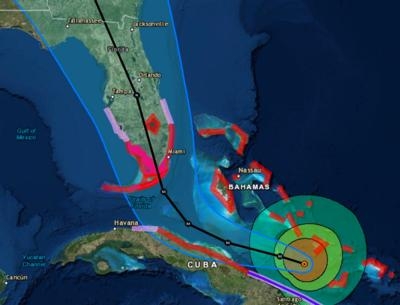Sat, Sep 09, 2017
Reminds Drone Users To Keep Their Aircraft On The Ground During And After The Storm
The FAA closely monitors forecasted hurricanes and severe weather events and prepares FAA facilities and equipment to withstand storm damage. The agency prepares and protects air traffic control facilities along the projected storm path so operations can quickly resume after the hurricane passes. Enabling flights to resume quickly is critical to support disaster relief efforts.

FAA control towers in hurricane-prone areas are designed and built to sustain hurricane force winds. Each control tower has a maximum wind sustainability. When the winds approach that level, controllers evacuate the tower cabs. They may remain in the building on duty in a secure lower level, and are ready to go back to work as soon as the storm passes.
We also protect communications equipment and navigational aids to the greatest extent possible. As the storm approaches, we disable airport surveillance radar antennas to allow them to spin freely, minimizing potential wind damage. This limits damage to the antenna motors and allows radar coverage to resume quickly after the storm passes.
Airports and associated facilities including terminal buildings, parking lots and access roads are operated by local organizations that decide when to close to commercial operations and when they can safely reopen. The FAA does not decide if or when airports or other local facilities close or reopen. Some airports in a disaster area may stay closed to the public for several days in the wake of a storm to support the response and recovery effort or because roads to and from the airport are inaccessible. FAA air traffic controllers always are ready to safely resume air traffic control service when airports reopen, and frequently are managing air traffic operations for response and recovery flights while airports are closed to the general public.
Commercial Travelers
Due to Hurricane Irma, airlines are likely to cancel many flights in the direct path of the storm and the surrounding area. Flights that are not cancelled may be delayed. Please continue to check the status of your flight with your airline. You can also check the status of some major airports in the storm path by visiting Fly.FAA.gov, which is continuously updated.
Drone Users
The FAA warns unauthorized drone operators that they may be subject to significant fines if they interfere with emergency response operations. Many aircraft that are conducting life-saving missions and other critical response and recovery efforts are likely to be flying at low altitudes over areas affected by the storm. Flying a drone without authorization in or near the disaster area may unintentionally disrupt rescue operations and violate federal, state, or local laws and ordinances, even if a Temporary Flight Restriction (TFR) is not in place. Allow first responders to save lives and property without interference.
Government agencies with an FAA Certificate of Authorization (COA) and private sector Part 107 drone operators who want to fly to support of response and recovery operations are strongly encouraged to coordinate their activities with the local incident commander responsible for the area in which they want to operate.
If UAS operators need to fly in controlled airspace or a disaster TFR to support the response and recovery, operators must contact the FAA for authorization. Each TFR has the appropriate contact information.
General Aviation Pilots
General aviation pilots should check the FAA’s Notices to Airman (NOTAMs) before flying and review the latest information on flight restrictions in the areas affected by Hurricane Irma. You can monitor TFRs at TFR.FAA.gov and @FAANews on Twitter for the latest information. Regardless of where you are flying, always be aware of the weather conditions along your entire planned route. Contact your destination airport before you take off to obtain the most current information about local weather and airfield conditions. Remember that standard check lists are even more important in and around severe weather. Be aware of weather conditions throughout the entire route of your planned flight. A pilot’s failure to recognize deteriorating weather conditions continues to cause or contribute to accidents.
(Source: FAA news release)
More News
States That Current Process is Damaging National Aerospace Development US Senator Jerry Morgan is pushing the FAA to speed up the process for rocket launch licensing. He argues tha>[...]
From 2015 (YouTube Edition): Model Aviator Aims For Full-Scale Career While at the 2015 Indoor Electric RC Festival, referred to as eFest, ANN CEO and Editor-In-Chief, Jim Campbell>[...]
Dave Juwel's Aviation Marketing Stories ITBOA BNITBOB ... what does that mean? It's not gibberish, it's a lengthy acronym for "In The Business Of Aviation ... But Not In The Busine>[...]
Aero Linx: Cardinal Flyers Online The Cardinal Flyers Online Web site was created and is maintained by me, Keith Peterson. My wife Debbie and I have owned a 1976 RG since 1985. Wit>[...]
Clearance Void If Not Off By (Time) Used by ATC to advise an aircraft that the departure release is automatically canceled if takeoff is not made prior to a specified time. The exp>[...]
 Senator Pushes FAA to Accelerate Rocket Launch Licensing
Senator Pushes FAA to Accelerate Rocket Launch Licensing Classic Aero-TV: RJ Gritter - Part of Aviations Bright New Future
Classic Aero-TV: RJ Gritter - Part of Aviations Bright New Future Aero-FAQ: Dave Juwel's Aviation Marketing Stories -- ITBOA BNITBOB
Aero-FAQ: Dave Juwel's Aviation Marketing Stories -- ITBOA BNITBOB ANN's Daily Aero-Linx (10.27.24)
ANN's Daily Aero-Linx (10.27.24) ANN's Daily Aero-Term (10.27.24): Clearance Void If Not Off By (Time)
ANN's Daily Aero-Term (10.27.24): Clearance Void If Not Off By (Time)



